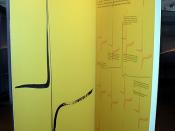Compare and contrast the conductive versus the conductive versus the contractile cardiac muscle fibers. Describe their arrangement in the heart and explain the roles each play in the contraction of the heart.
Contractile
÷ Striated
÷ Has intercalated discs - gap junctions
÷ 1-2 nuclei
÷ Branching
÷ Aerobic ONLY (highly enriched with mitochondria)
÷ T-tubules, SR
÷ Pacemaker potential
÷ If cardiac muscle is stretched, it causes stronger contractions.
÷ No temporal summation, tetanus and no motor units.
The myocardium (muscle heart) made up of mainly cardiac muscle forms most of the heart. Myocardium is the layer that actually contracts. Within the myocardial layer, the branching cardiac muscle cells are joined together by crisscrossing CT fibers and are arranged in spiral or circular bundles. The interlacing bundles link all parts of the heart together. The CT fibers form a dense network call fibrous skeleton of the heart, which reinforces the myocardium internally and anchors the cardiac muscle fibers.
Conductive
÷ Do not contract
÷ Do not have striations
÷ Pacemaker potential due to decrease in K+ permeability
÷ No Na+ gates
Conductive muscle fibers are located in the nodes:
÷ SA node (Right atrium)
÷ AV node (Between atrium & ventricular walls)
÷ Bundle of His (Septum & ventricular)
÷ Purkinje (Septum & ventricular walls)
Pacemaker potential (spontaneously changing membrane potential) initiates the AP, which spread throughout the heart to trigger its rhythmic contractions.
1. SA node - generates typically impulses about 75 times a minute. Because no other region of the conduction system or the myocardium has a faster depolarization rate, the SA sets the pace for the heart. It is the hearts pacemaker and its sinus rhythm determines the heart rate.
2. AV node - From the SA node, the depolarization wave spreads using gap junctions...


